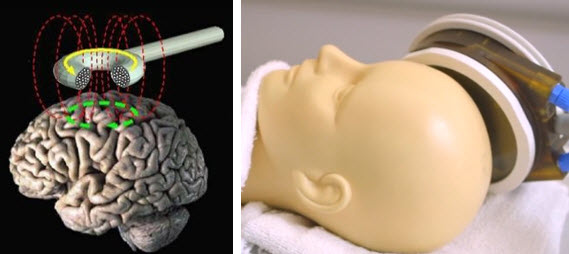New targeted, noninvasive treatments for mental illness to combine TMS and ultrasound
November 26, 2014

Transcranial magnetic stimulation can stimulate brain circuits near the surface for treating conditions like depression and anxiety; ultrasound (right) can reach deeper into the brain and more precisely. Stanford researchers hope to combine them. (Credit: Wikimedia Commons and Stanford University)
A new interdisciplinary Stanford University initiative called NeuroCircuit aims to find the specific brain circuits that are responsible for mental-health conditions and then develop ways of noninvasively stimulate those circuits to potentially lead to improved treatments for depression, anxiety, and post-traumatic stress disorder.
“You see things activated in brain images but you can’t tell just by watching what is cause and what is effect,” said Amit Etkin, Neurocircuit co-leader and a Stanford assistant professor of psychiatry and behavioral sciences. “Right now, if a patient with a mental illness goes to see their doctor they would likely be given a medication that goes all over the brain and body. While medications can work well, they do so for only a portion of people and often only partially.”
Etkin has been working with transcranial magnetic stimulation (TMS) to map and remotely stimulate parts of the brain. A TMS device generates a strong magnetic field that stimulates brain circuits near the surface. TMS is currently used as a way of treating depression and anxiety, but Etkin said the brain regions being targeted are the ones available to TMS, not necessarily the ones most likely to treat a person’s condition. They are also not personalized for the individual.
The solution may involve combining TMS with ultrasound. In his lab, Baccus has been using ultrasound to stimulate nerve cells of the retina to develop a prosthetic retina. Other members of the team are modifying existing ultrasound technology to direct it deep within the brain at a safe frequency. If the team is successful, ultrasound could be a more targeted and focused tool than TMS for remotely stimulating circuits that underlie mental health conditions.
Baccus said that before merging with Etkin’s team they had been focusing on the technology without specific brain diseases in mind. “This merger really gives a target and a focus to the technology.”
The initiative is part of the Stanford Neurosciences Institute‘s Big Ideas, which bring together teams of researchers from across disciplines to solve major problems in neuroscience and society.
Stanford University/Kurt Hickman | Researchers hope to find the brain circuits that are responsible for mental
health conditions, develop ways to remotely stimulate those circuits, and potentially treat those conditions.